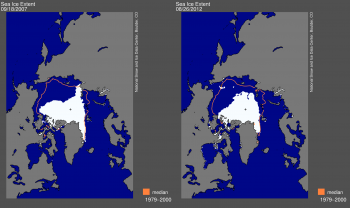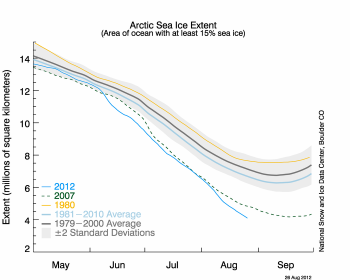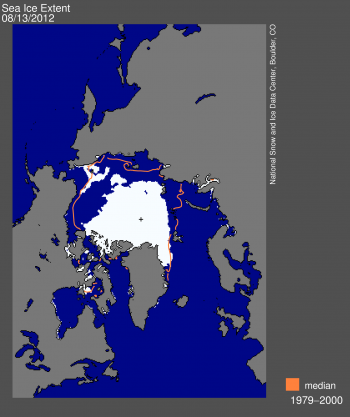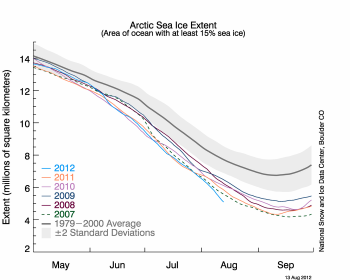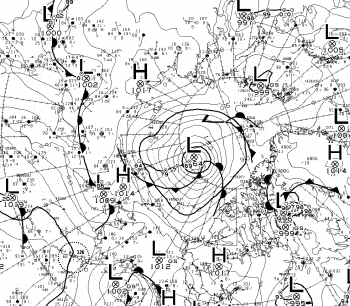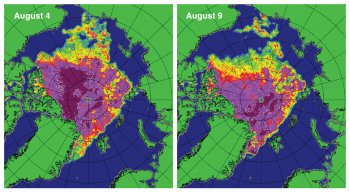Arctic sea ice extent declined quickly in July, continuing the pattern seen in June. On August 1, ice extent was just below levels recorded for the same date in 2007, the year that saw the record minimum ice extent in September. Low sea ice concentrations are present over large parts of the western Arctic Ocean. Warm conditions dominated the weather for most of the Arctic Ocean and surrounding lands. For a brief period in early July, nearly all of the Greenland ice sheet experienced surface melt, a rare event.
Overview of conditions
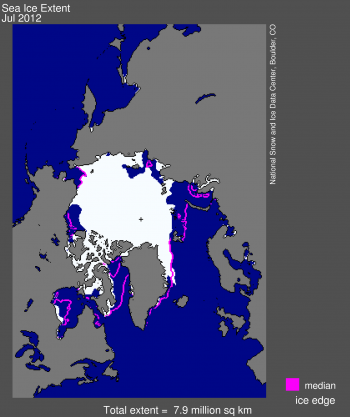
Figure 1. Arctic sea ice extent for July 2012 was 7.94 million square kilometers (3.07 million square miles). The magenta line shows the 1979 to 2000 median extent for that month. The black cross indicates the geographic North Pole. Sea Ice Index data. About the data
Credit: National Snow and Ice Data Center
High-resolution image
Arctic sea ice extent for July 2012 averaged 7.94 million square kilometers (3.07 million square miles). This was 2.12 million square kilometers (819,000 square miles) below the 1979 to 2000 average extent. July 2012 ice extent was 20,000 square kilometers (7,700 square miles) above the 2011 record July low.
As throughout the summer, the low ice extent for the Arctic as a whole is primarily due to extensive open water on the Atlantic side of the Arctic (Kara, Laptev and East Siberian seas) and the Beaufort Sea. By August 1, open water in the Laptev Sea, along the Siberian coast, had reached nearly 80oN latitude. Ice extent remains near average in the Chukchi Sea, and ice continues to block sections of the both the Northern Sea Route and the Northwest Passage. The ice extent recorded for August 1 of 6.53 million square kilometers (2.52 million square kilometers) is the lowest in the satellite record. The previous record for the same date was set in 2007 at 6.64 million square kilometers (2.56 million square miles), when the current record low September ice extent was set.
Conditions in context
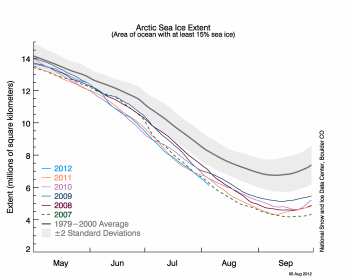
Figure 2. The graph above shows Arctic sea ice extent as of August 5, 2012, along with daily ice extent data for the 2011 and for 2007, the record low year. 2012 is shown in blue, 2011 in orange, and 2007 in green. The gray area around the average line shows the two standard deviation range of the data. Sea Ice Index data.
Credit: National Snow and Ice Data Center
High-resolution image
In July, the Arctic lost a total of 2.97 million square kilometers (1.15 million square miles) of ice. The largest July total loss, 3.53 million square kilometers (1.36 million square miles) occurred in the year 2007. Warm conditions prevailed over most of the Arctic Ocean; temperatures at the 925 hPa level (about 3,000 feet above the ocean surface) were typically 1 to 3 degrees Celsius (1.8 to 5.4 degrees Fahrenheit) above the 1981 to 2010 average over the Beaufort Sea and regions to the north, as well as over Baffin Bay. By contrast, temperatures were 1 to 3 degrees Celsius below average over the Norwegian Sea. Weather patterns over the Arctic Ocean varied substantially through the month, as they have done throughout the melt season.
July 2012 compared to recent years
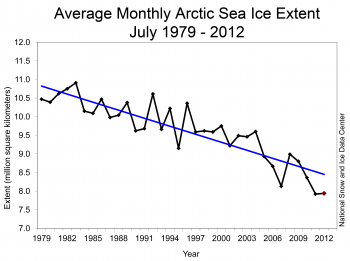
Figure 3. Monthly July ice extent for 1979 to 2012 shows a decline of 7.1% per decade.
Credit: National Snow and Ice Data Center
High-resolution image
Arctic sea ice extent for July 2012 was the second lowest in the satellite record, behind 2011. Through 2012, the linear rate of decline for July Arctic ice extent over the satellite record is 7.1% per decade.
MODIS data shows low concentration ice
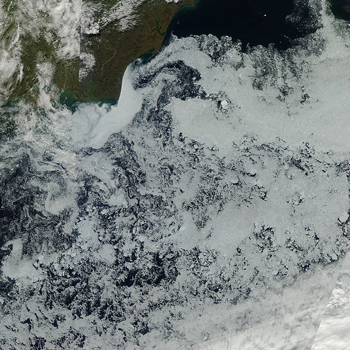
Figure 4. This image from the Moderate Resolution Imaging Spectroradiometer (MODIS), taken in late July, shows areas of low concentration sea ice in the Beaufort Sea, north of Alaska. Barrow, Alaska is at the top left. The resolution is 500 meters. The cloud band covering much of the lower right part of the image is associated with an approaching storm.
Credit: NASA Goddard Space Flight Center, Rapid Response
High-resolution image
In our last post (July 24, 2012) we commented on large areas of low ice concentration depicted in Special Sensor Microwave Imager/Sounder (SSMIS) data in the Beaufort and Chukchi seas, the Canadian Archipelago, the East Greenland Sea, and north of Siberia. These areas of low ice concentration ice can be seen clearly in visible-band data collected by the Moderate Resolution Imaging Spectroradiometer (MODIS) aboard NASA’s Aqua and Terra satellites.
The MODIS image shows polygonal floes of multi-year ice, as well as thin, gray first-year ice, and dark open water in the Beaufort Sea, north of Alaska. Most of these areas of low concentration ice will likely melt over the next month. Because MODIS senses light reflected from the surface as opposed to the emission of microwave radiation, its ability to see the surface depends on cloud cover.
Comparisons between observed and modeled September sea ice trends
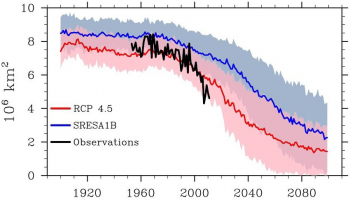
Figure 5. This figure shows the observed September sea ice extent for 1952 to 2011 (bold black line) and extents for 1900 to 2100 from the CMIP3 models using the “business as usual” SRESA1B greenhouse gas emissions scenario (the blue line averaging results from all of the model runs with the blue shading showing the +/- 1 standard deviation of the different model runs) and from the CMIP5 archive, using the RCP 4.5 scenario (pink line and pink shading). The darker pink shading shows where the simulations from CMIP3 and CMIP5 overlap each other.
Credit: National Snow and Ice Data Center courtesy Stroeve et al. 2012
High-resolution image
Previous research at NSIDC documented that September Arctic ice extent has declined faster than models predicted it would. The comparison was between observations and simulated trends from models participating in the World Climate Research Programme Coupled Model Intercomparison Project Phase 3 (CMIP3). These climate models were used in the 2007 4th Assessment report of the Intergovernmental Panel on Climate Change (IPCC). In a new paper, Stroeve et al. (2012) compared the observed 1979-2011 September trend for the Arctic against trends over the same period from the next generation of models in the CMIP5 archive. While the newer CMIP5 models do a better job of simulating the observed trend, most of the modeled ice extent trends are still smaller than the observed downward trend. NSIDC is working with researchers to further improve the models, which help extend and refine our understanding of the climate system.
Extensive melt over the Greenland Ice Sheet
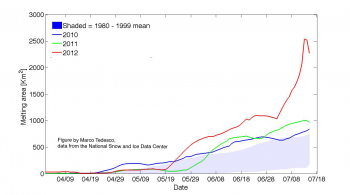
Figure 6. This figure shows the daily, cumulative area of the Greenland ice sheet showing surface melt for 2012, 2011, 2010 and for the 1980 to 1999 mean. While melt was unusually extensive through May and June of 2012, the melt area increased rapidly in early July in response to an unusually warm weather event.
Credit: National Snow and Ice Data Center courtesy Marco Tedesco, CUNY
High-resolution image
This summer, the ocean has not been the only place where unusual melt has been observed in the Arctic. NASA researchers reported that for several days in early July, nearly the entire Greenland ice sheet experienced a brief period of surface melt, including at the summit of the ice sheet. Typically, about half of the ice sheet sees some surface melting during summer, but this tends to be confined to the lower elevations. The 2012 event was associated with a high-pressure weather pattern bringing unusually warm temperatures over the higher elevations of the ice sheet. While the event has not been seen previously in the 34-year satellite record, there is evidence in ice core data from Summit, Greenland of similar events occurring several times over the past few thousand years. These melt events recorded in the ice cores from Summit show an overall average frequency of about once every 150 years since the end of the last ice age. Perhaps more important, however, is the extraordinary high melting occurring this year around the lower elevations in Greenland. Figure 6 shows that the first few months of melt exceeded past higher-than-average melt seasons. Flooding and damage to structures has been reported in some areas where this melt runs off the ice sheet and fills streams and rivers along the Greenland coast. The surface melt runoff, as well as the flow of ice and the resulting calving of icebergs, are contributors to sea level rise. Along with the substantial summer sea ice extent decline and the early Northern Hemisphere snow melt, the pace of Greenland surface melt suggests that 2012 is yet another interesting summer in the Arctic.
For more information and images, visit Greenland Melting.
References
Stroeve, J. C., V. Kattsov, A. P. Barrett, M. C. Serreze, T. Pavlova, M. M. Holland, and W. N. Meier. 2012. Trends in Arctic sea ice extent from CMIP5, CMIP3 and observations. Geophys. Res. Lett., doi:10.1029/2012GL052676, in press.
